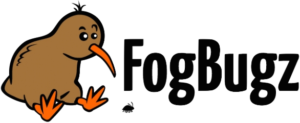Kore.ai provides integration for a built-in FogBugz Bot that you can use to display message notifications and execute tasks directly from the Kore.ai application. To use the FogBugz Bot, you just need to add the Bot to your Kore.ai account, and then configure the settings for the Bot, such as authentication to access FogBugz, and the notification messages that you want. This topic describes the FogBugz built-in Bot for Kore.ai. For more information about other Kore.ai Bots, see Adding Bots.
About the Kore.ai Bot for FogBugz
 FogBugz tracks bugs and issues through every stage of the development process. It allows you to organize work and prioritize what’s important, so that you and your team can focus and know exactly what needs to be done and when.
FogBugz tracks bugs and issues through every stage of the development process. It allows you to organize work and prioritize what’s important, so that you and your team can focus and know exactly what needs to be done and when.
| Integration Type | Webhook – Connect to this Bot using a webhook integration where the web application pushes message notifications in near real time. |
| Category | Collaboration – This Bot is available in the Kore.ai application in the Collaborationcategory. |
Configuring FogBugz
To configure a FogBugz webhook for Kore.ai, you must have a FogBugz account with administrator access as well as API access to configure a webhook. If you don’t, you’ll need to contact the FogBugz system administrator for your company. For more information, see Permissions in the FogBugz documentation.
To get started configuring the webhook in FogBugz, you’ll need two things:
- The Kore.ai webhook URL provided when you set up an alert in your Kore.ai account for each alert that you want to enable in FogBugz.
- A valid Username and Password for an account with FogBugz API access.
The webhook URL is account-specific and cannot be transferred to any other account. This means that if you configure a FogBugz webhook using a test account, you will have to recreate the alert and get a new webhook URL to configure in FogBugz. The following URL is an example webhook URL.
https://company.kore.com/hooks/c6089802f36250c179dcb1aa29afd24c
Configuring Webhook
This procedure describes the steps in FogBugz to configure a webhook using a Kore.ai webhook URL endpoint.
- Log on to FogBugz, and then on the top menu bar, click the Settings
 icon, and then on the Settings menu, click Webhooks. The Webhooks page is displayed.
icon, and then on the Settings menu, click Webhooks. The Webhooks page is displayed. - Click Add New Hook.
- In the Event Types dialog, select one or more of the events in FogBugz that you want to use to generate an alert for Kore.ai.
- In the URL field, enter the Kore.ai webhook URL for the alert.
- In the Triggers section, select one or more events that you want to get Kore.ai alert messages for.
- Select POST to use the POST HTTP Method for Kore.ai.
- Click Save to save the webhook configuration and close the dialog.
For more information, see Webhooks in the FogBugz documentation.
Note: By default, all events for this Bot generate Kore.ai alert messages. To reduce the number of notifications, this Bot may have filters that can be defined when you set up the alert in your Kore.ai account.
You can setup message notifications to your Kore.ai account using a FogBugz webhook. Click ![]() , click Get notified when…, click Case Updates, and then in the Setup Task dialog:
, click Get notified when…, click Case Updates, and then in the Setup Task dialog:
- click the Activate button to generate a Webhook URL.
- copy and save the URL, or click Email Instructions to send the URL to an email account. For more information, see Configuring FogBugz Webhooks.
- optionally customize the Task Name
- optionally customize the Short Description
- enable or disable Mute task notifications.
Next Steps
After the webhook is configured in FogBugz, when any of the events occur in FogBugz, a message is displayed on the Bots tab in the Messages section for the Kore.ai account.
